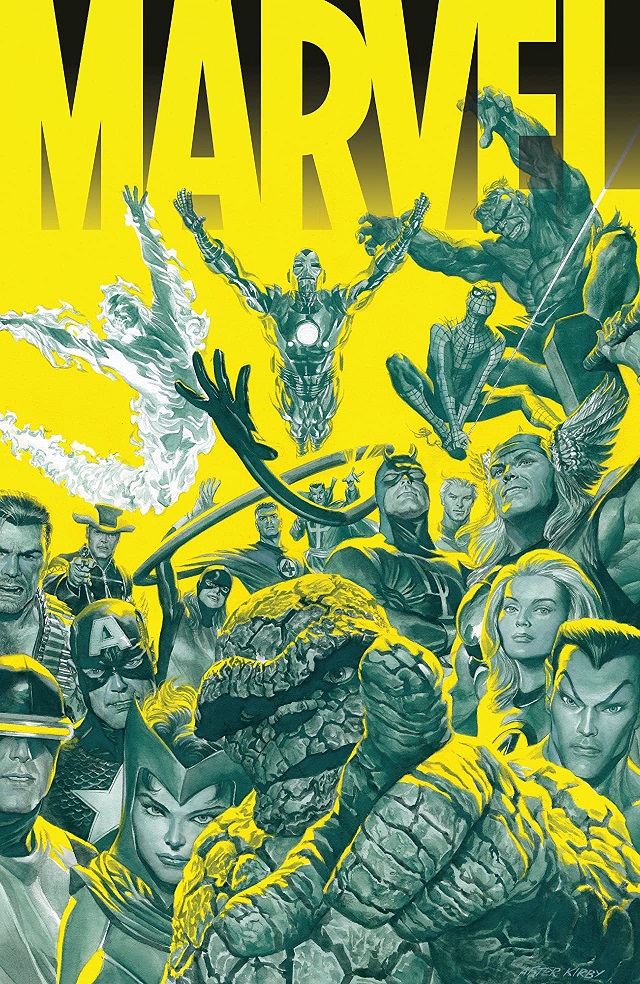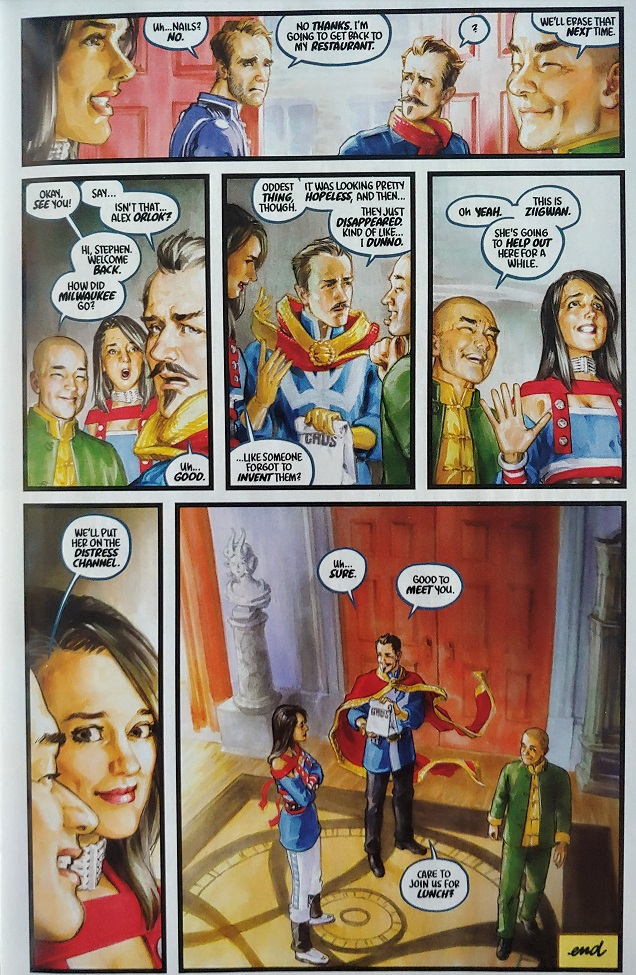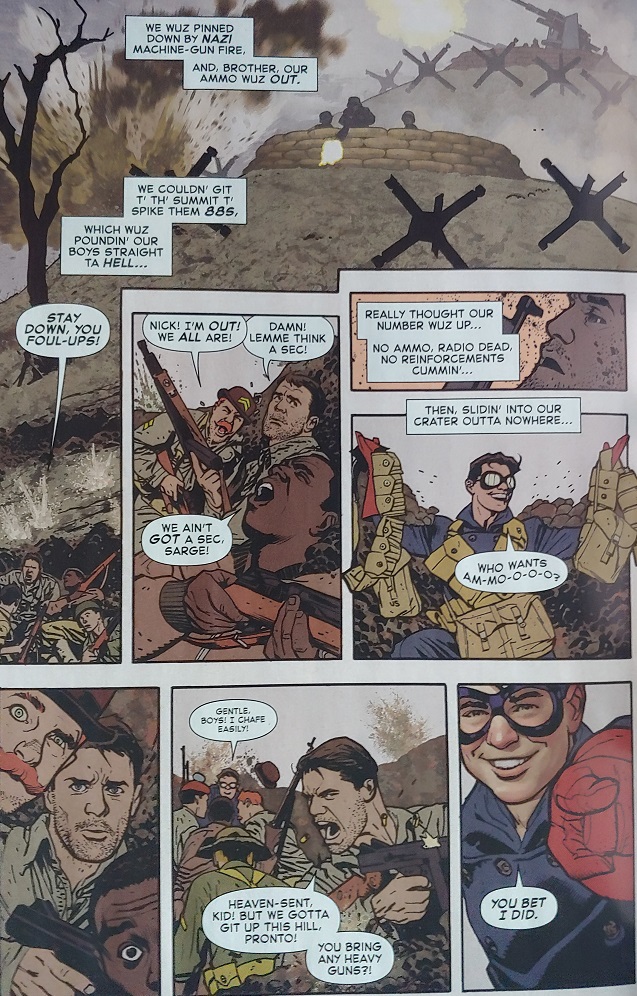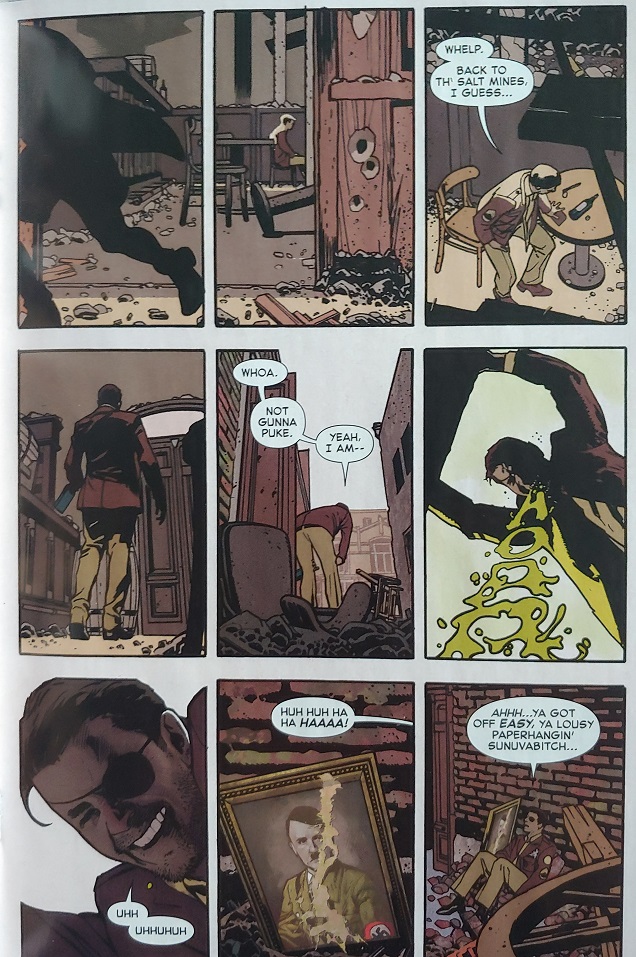A year ago I reviewed Captain America Tribute, an interesting Marvel project that consisted in adapting the first stories of the Sentinel of Liberty, by asking the best contemporary artists to illustrate again the iconic pages of yesteryear. In a similar, Giant Size X-Men preserves the original dialogs by Len Wein with stunning new art, each page is “a glorious example of the creativity and talent of today’s comic book artists”. True, some people might miss the original Dave Cockrum pages, but hey, those have been reprinted on multiple occasions and can be easily found online and in print.
 |
| Adi Granov |
Giant-Size X-Men # 1 was published in July 1975, and not only resurrected the mutants franchise but also made it the most popular Marvel title. In the words of Chris Claremont “Len and Dave laid the foundation, in a debut issue that remains a marvel (so to speak) of power and storytelling clarity, introducing its characters and situations with an eloquence and economy that many titles today might do well to emulate”. It certainly was a fundamental issue for Marvel comics, and in November 2020, to commemorate the 45th anniversary of its publication, this special tribute was released. For those interested in reading my review about the original Giant Size X-Men simply click here.
 |
| Alex Ross |
Let’s start with the cover, by the always amazing Adi Granov, an artist that I admire for his realistic style and care for details. Granov produces a beautiful composition faithful to the original Gil Kane & Dave Cockrum cover, however, as much as I love Granov, I keep getting the feeling that Kane & Cockrum really did make the characters burst out of the page, with more energy and dynamism, while they look slightly static in Granov’s version. I will say, however, that the background with the founding member of the X-Men look better in Granov’s cover.
 |
| Mark Brooks |
The first page is wonderfully illustrated by Alex Ross, proving why he is an absolute mastery of anatomy and lighting, and one of the best representatives of the hyperrealism style. The splash page of chapter 2 is also a fantastic illustration by the talented Mark Brooks. I’ve always wanted to review more Brooks comics but for some reason I haven’t had the time to do so. At least here you can see this glorious page. My only complaint here would about the lettering, which kind of interferes with the art, in comparison, the lettering from 1975 is way more efficient.
Although I usually like Rod Reis, his reinterpretation of Krakoa, the island that walks like a man, is perhaps a bit simplistic, forgetting the wonderful details that Cockrum added to the original page. While Ross and Brooks actually improve the Cockrum pages, Reis is easily defeated by the veteran artist. The next page I’m including here is by Mike del Mundo and Marco D'Alfonso, who do a magnificent job together. Finally, I must say I really enjoyed the page by Marco Checchetto. If you check my review of Giant Size X-Men then you can compare the old and new pages.
 |
| Rod Reis |
Other artists that participate in this special tribute were Kevin Nowlan, Chris Samnee, Matthew Wilson, Marcus To, Sunny Gho, Siya Oum, Stephen Segovia, Rain Beredo, Marguerite Sauvage, Carmen Carnero, David Curiel, Bernard Chang, Marcelo Maiolo, Aaron Kuder, Jordie Bellaire, Takeshi Miyazawa, Ian Herring, Juann Cabal, Federico Blee, Gurihiru, Kris Anka, Phil Noto, Valerio Schiti, Mattia Iacono, Leinil Francis Yu, Matteo Lolli, Ruth Redmond, Ema Lupacchino, David Curiel, Carlos Gomez, Carlos Lopez, Iban Coello, Marte Gracia, R.B. Silva, Jesus Aburtov, Ramon Rosanas, Joshua Cassara, Tamra Bonvillain, David Baldeon, Marcelo Ferreira, Roberto Poggi, Rachelle Rosenberg, Javier Garrón, Javier Rodriguez, Alvaro Lopez, Pepe Larraz, Jen Bartel, Rahzzah and Mike Hawthorne.
________________________________________________________________________________________________________
________________________________________________________________________________________________________
Hace un año reseñé el Captain America Tribute, un interesante proyecto de Marvel que consistía en adaptar las primeras historias del Centinela de la Libertad, pidiéndoles a los mejores artistas contemporáneos que ilustraran de nuevo las icónicas páginas de antaño. De manera similar, Giant Size X-Men conserva los diálogos originales de Len Wein con un arte nuevo e impresionante, cada página es “un glorioso ejemplo de la creatividad y el talento de los artistas de cómics de hoy”. Es cierto que algunas personas pueden extrañar las páginas originales de Dave Cockrum, pero bueno, se han reeditado en múltiples ocasiones y se pueden encontrar fácilmente impresas y en línea.
Giant-Size X-Men # 1 se publicó en julio de 1975 y no sólo resucitó la franquicia de los mutantes, sino que también la convirtió en el título más popular de Marvel. En palabras de Chris Claremont, “Len y Dave sentaron las bases, en un número de debut que sigue siendo una maravilla (por así decirlo) de poder y claridad narrativa, presentando a sus personajes y situaciones con una elocuencia y economía que muchos títulos de hoy en día podrían hacer bien en emular". Sin duda fue un número fundamental para los cómics de Marvel, y en noviembre de 2020, para conmemorar el 45 aniversario de su publicación, se editó este homenaje especial. Para aquellos interesados en leer mi reseña sobre el Giant Size X-Men original, simplemente hagan clic aquí.
 |
| Mike del Mundo |
Empecemos por la portada del siempre genial Adi Granov, un artista al que admiro por su estilo realista y cuidadosos detalles. Granov produce una hermosa composición, fiel a la portada original de Kane y Cockrum, sin embargo, a pesar de lo mucho que me encanta Granov, sigo teniendo la sensación de que Kane & y Cockrum realmente lograron que los personajes saltaran de la página, con más energía y dinamismo, mientras que en la versión de Granov se ven un poco estáticos. Sin embargo, diré que el fondo con los miembros fundadores de los X-Men queda mejor en la portada de Granov.
La primera página está maravillosamente ilustrada por Alex Ross, demostrando por qué es un absoluto maestro de la anatomía y la iluminación, y uno de los mejores representantes del estilo hiperrealista. La página de inicio del capítulo 2 también es una fantástica ilustración del talentoso Mark Brooks. Siempre he querido reseñar más cómics de Brooks, pero por alguna razón no he tenido tiempo para hacerlo. Al menos aquí se puede ver esta gloriosa página. Mi única queja aquí sería sobre el rotulado, que interfiere con el arte, en comparación, los rotulados de 1975 son mucho más eficientes.
 |
| Marco Checchetto |
Aunque me suele gustar Rod Reis, su reinterpretación de Krakoa, la isla que camina como un hombre, es quizás un poco simplista, olvidándose de los maravillosos detalles que añadió Cockrum a la página original. Mientras que Ross y Brooks mejoran las páginas de Cockrum, Reis es derrotado fácilmente por el artista veterano. La siguiente página que incluyo aquí es de Mike del Mundo y Marco D'Alfonso, quienes hacen un magnífico trabajo juntos. Finalmente, debo decir que disfruté mucho la página de Marco Checchetto. Si revisan mi reseña de Giant Size X-Men, podrán comparar las páginas antiguas con las nuevas.
Otros artistas que participaron en este tributo especial fueron Kevin Nowlan, Chris Samnee, Matthew Wilson, Marcus To, Sunny Gho, Siya Oum, Stephen Segovia, Rain Beredo, Marguerite Sauvage, Carmen Carnero, David Curiel, Bernard Chang, Marcelo Maiolo, Aaron Kuder , Jordie Bellaire, Takeshi Miyazawa, Ian Herring, Juann Cabal, Federico Blee, Gurihiru, Kris Anka, Phil Noto, Valerio Schiti, Mattia Iacono, Leinil Francis Yu, Matteo Lolli, Ruth Redmond, Ema Lupacchino, David Curiel, Carlos Gomez, Carlos Lopez, Iban Coello, Marte Gracia, R.B. Silva, Jesus Aburtov, Ramon Rosanas, Joshua Cassara, Tamra Bonvillain, David Baldeon, Marcelo Ferreira, Roberto Poggi, Rachelle Rosenberg, Javier Garron, Javier Rodriguez, Alvaro Lopez, Pepe Larraz, Jen Bartel, Rahzzah y Mike Hawthorne.








































